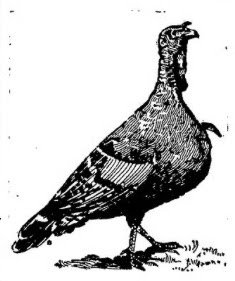Turkey Day
Thanksgiving is among the best holidays on the calendar. Every year I drive home, sit down with my family and eat. I watch the first 20-50 minutes of the Godfather, while my father falls asleep on the couch (Usually I wait out the wedding scene and then change the channel). We watch football and I endure an avalanche of texts from my friends reminding me of the ButtFumble (the joys of rooting for the JETS). After supper there is pecan pie and for the next week there is turkey for every meal.
Colloquially, Thanksgiving is referred to as Turkey Day, however in St. Lawrence County Turkey Day refers to something much different. Historically, Turkey Day denoted two very important days, the first about a week before Thanksgiving, and the second a week before Christmas. On Turkey Days farmers from across the county drove flocks of turkeys into the towns of Lisbon, Heuvelton, and Madrid. These three towns had depots for the Rutland Railroad and farmers would drive their flocks right to the railroad tracks where poultry dealers would purchase the birds and ship them to major cities like Boston, Montreal, and New York City where they'd be eaten for holiday supper. This was big business for well over fifty years and Heuvelton was home to the world's largest dressed turkey market for over forty years. Nearby, in my hometown of Lisbon, the Turkey Day of November 23, 1933 saw around eighty farmers haggling over, and eventually selling, twelve tons of turkey to downstate poultry dealers. Madrid's Turkey Day frequently saw between twenty and thirty tons of turkey sold and individual farmers, such as Allen Wears and John Haig sometimes sold upwards of 8,000 pounds of turkey in a single day.
A flock of turkeys awaiting their train. Photo taken from Northcountrynow.com
While dedicated farmers like Wears and Haig often recorded massive hauls, most farmers grew far smaller flocks and used Turkey Days to generate supplemental income. These smaller turkey flocks were most frequently managed by farmwomen who would purchase a tom and two hens, from which they could expect around fifty poults in the spring. Over the summer and early fall these poults were raised, fattened on seed, and protected from marauding foxes and raccoons. Once fall arrived farmers began to eye the newspapers and put an ear to the ground to try and glean information about how much turkeys were going for in the much smaller downstate turkey markets. At their lowest, Grade A dressed turkeys sold for twenty-three cents in 1933 while the birds had peaked at sixty-three cents a pound just eight years earlier in 1925. With these sorts of wild swings local farmers had to be incredibly cagey and would shop their birds at different Turkey Days, if they didn't like the prices at Thanksgiving, they would pack up their birds and wait until Christmas.
Turkey Day could also be a festive event, so long as the buyers were fair and the birds heavy. Starting in the 1930s Ogdensburg started to promote Turkey Day like a minor holiday, promoting the sale throughout New York in order to attract poultry dealers and offering dressed hogs in addition to turkeys. In 1933 Ogdensburg's merchants association offered $15 dollars to whoever brought the largest dressed turkey to the farmers market and promised to send the bird to Washington where it would sit President Roosevelt's holiday table.
Turkey Day even had local experts who advised farmers in the proper rearing and management of their flocks. In 1939 Professor E.L. Smith of Cornell University, ran a series of discussions with local farmers, educating them on the best ways to dress their birds, how mature a bird should be before being killed, and even describing the physical characteristics of a Grade A dressed turkey
Turkey Day remained an important part of life in St. Lawrence County until the 1960s when the Rutland Railroad shut down and all the local train stations were shuttered. Without an effective method to deliver turkeys to downstate markets the industry faded and turkeys ceased to be a major cash crop in St. Lawrence County. After the 1960s, farmers raised turkeys for their own consumption and the streets of Heuvelton, Lisbon, and Madrid no longer echoed with the cackling of thousands of turkeys and the haggling of poultry dealers and local farmers.
Heuvelton in 1905 during Turkey Day.
Photo from North Country Public Radio




